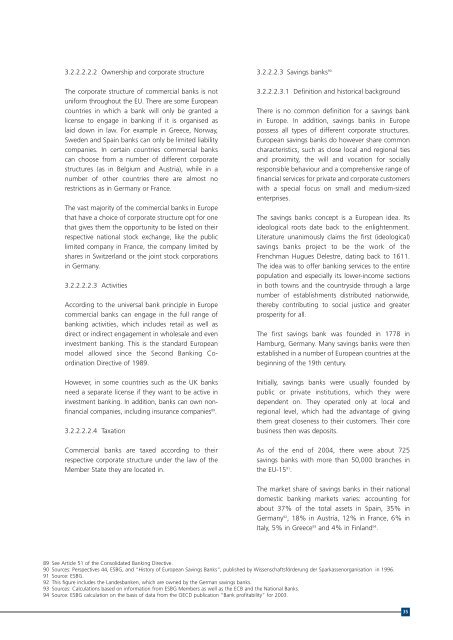A comparative analysis of the US and EU retail banking markets - Wsbi
A comparative analysis of the US and EU retail banking markets - Wsbi
A comparative analysis of the US and EU retail banking markets - Wsbi
Create successful ePaper yourself
Turn your PDF publications into a flip-book with our unique Google optimized e-Paper software.
3.2.2.2.2.2 Ownership <strong>and</strong> corporate structure<br />
The corporate structure <strong>of</strong> commercial banks is not<br />
uniform throughout <strong>the</strong> <strong>EU</strong>. There are some European<br />
countries in which a bank will only be granted a<br />
license to engage in <strong>banking</strong> if it is organised as<br />
laid down in law. For example in Greece, Norway,<br />
Sweden <strong>and</strong> Spain banks can only be limited liability<br />
companies. In certain countries commercial banks<br />
can choose from a number <strong>of</strong> different corporate<br />
structures (as in Belgium <strong>and</strong> Austria), while in a<br />
number <strong>of</strong> o<strong>the</strong>r countries <strong>the</strong>re are almost no<br />
restrictions as in Germany or France.<br />
The vast majority <strong>of</strong> <strong>the</strong> commercial banks in Europe<br />
that have a choice <strong>of</strong> corporate structure opt for one<br />
that gives <strong>the</strong>m <strong>the</strong> opportunity to be listed on <strong>the</strong>ir<br />
respective national stock exchange, like <strong>the</strong> public<br />
limited company in France, <strong>the</strong> company limited by<br />
shares in Switzerl<strong>and</strong> or <strong>the</strong> joint stock corporations<br />
in Germany.<br />
3.2.2.2.2.3 Activities<br />
According to <strong>the</strong> universal bank principle in Europe<br />
commercial banks can engage in <strong>the</strong> full range <strong>of</strong><br />
<strong>banking</strong> activities, which includes <strong>retail</strong> as well as<br />
direct or indirect engagement in wholesale <strong>and</strong> even<br />
investment <strong>banking</strong>. This is <strong>the</strong> st<strong>and</strong>ard European<br />
model allowed since <strong>the</strong> Second Banking Coordination<br />
Directive <strong>of</strong> 1989.<br />
However, in some countries such as <strong>the</strong> UK banks<br />
need a separate license if <strong>the</strong>y want to be active in<br />
investment <strong>banking</strong>. In addition, banks can own nonfinancial<br />
companies, including insurance companies 89 .<br />
3.2.2.2.2.4 Taxation<br />
Commercial banks are taxed according to <strong>the</strong>ir<br />
respective corporate structure under <strong>the</strong> law <strong>of</strong> <strong>the</strong><br />
Member State <strong>the</strong>y are located in.<br />
3.2.2.2.3 Savings banks 90<br />
3.2.2.2.3.1 Definition <strong>and</strong> historical background<br />
There is no common definition for a savings bank<br />
in Europe. In addition, savings banks in Europe<br />
possess all types <strong>of</strong> different corporate structures.<br />
European savings banks do however share common<br />
characteristics, such as close local <strong>and</strong> regional ties<br />
<strong>and</strong> proximity, <strong>the</strong> will <strong>and</strong> vocation for socially<br />
responsible behaviour <strong>and</strong> a comprehensive range <strong>of</strong><br />
financial services for private <strong>and</strong> corporate customers<br />
with a special focus on small <strong>and</strong> medium-sized<br />
enterprises.<br />
The savings banks concept is a European idea. Its<br />
ideological roots date back to <strong>the</strong> enlightenment.<br />
Literature unanimously claims <strong>the</strong> first (ideological)<br />
savings banks project to be <strong>the</strong> work <strong>of</strong> <strong>the</strong><br />
Frenchman Hugues Delestre, dating back to 1611.<br />
The idea was to <strong>of</strong>fer <strong>banking</strong> services to <strong>the</strong> entire<br />
population <strong>and</strong> especially its lower-income sections<br />
in both towns <strong>and</strong> <strong>the</strong> countryside through a large<br />
number <strong>of</strong> establishments distributed nationwide,<br />
<strong>the</strong>reby contributing to social justice <strong>and</strong> greater<br />
prosperity for all.<br />
The first savings bank was founded in 1778 in<br />
Hamburg, Germany. Many savings banks were <strong>the</strong>n<br />
established in a number <strong>of</strong> European countries at <strong>the</strong><br />
beginning <strong>of</strong> <strong>the</strong> 19th century.<br />
Initially, savings banks were usually founded by<br />
public or private institutions, which <strong>the</strong>y were<br />
dependent on. They operated only at local <strong>and</strong><br />
regional level, which had <strong>the</strong> advantage <strong>of</strong> giving<br />
<strong>the</strong>m great closeness to <strong>the</strong>ir customers. Their core<br />
business <strong>the</strong>n was deposits.<br />
As <strong>of</strong> <strong>the</strong> end <strong>of</strong> 2004, <strong>the</strong>re were about 725<br />
savings banks with more than 50,000 branches in<br />
<strong>the</strong> <strong>EU</strong>-15 91 .<br />
The market share <strong>of</strong> savings banks in <strong>the</strong>ir national<br />
domestic <strong>banking</strong> <strong>markets</strong> varies: accounting for<br />
about 37% <strong>of</strong> <strong>the</strong> total assets in Spain, 35% in<br />
Germany 92 , 18% in Austria, 12% in France, 6% in<br />
Italy, 5% in Greece 93 <strong>and</strong> 4% in Finl<strong>and</strong> 94 .<br />
89 See Article 51 <strong>of</strong> <strong>the</strong> Consolidated Banking Directive.<br />
90 Sources: Perspectives 44, ESBG, <strong>and</strong> “History <strong>of</strong> European Savings Banks”, published by Wissenschaftsförderung der Sparkassenorganisation in 1996.<br />
91 Source: ESBG.<br />
92 This figure includes <strong>the</strong> L<strong>and</strong>esbanken, which are owned by <strong>the</strong> German savings banks.<br />
93 Sources: Calculations based on information from ESBG Members as well as <strong>the</strong> ECB <strong>and</strong> <strong>the</strong> National Banks.<br />
94 Source: ESBG calculation on <strong>the</strong> basis <strong>of</strong> data from <strong>the</strong> OECD publication “Bank pr<strong>of</strong>itability” for 2003.<br />
35
















